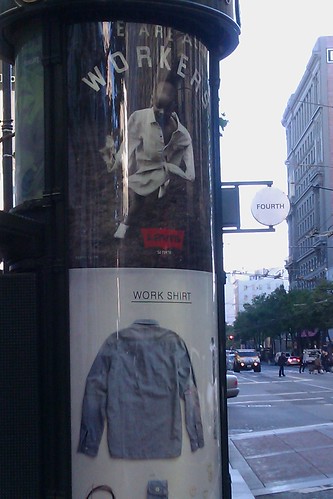
I spotted this Levi’s ad on Market Street downtown in SF, right in the heart of the shopping and financial district.
All this on the tail of a huge financial meltdown in our information/service/immaterial economy, rising unemployment, and sustainability crises that point their finger at us as a nation of consumers. And here, we have a consumer brand getting ahead of our anxieties by offering us the opportunity to consume worker-ness.
A press release gestures to “the history of laborers and artisans who shaped the cultural landscape of America.”
Levi’s is complementing their ad campaign by opening up workshops in SF and New York that double as community and retail spaces. The SF workshop will feature letterpresses, silk screen equipment, and photocopiers. New York will feature photography equipment.
At the very moment they pay homage to manual labor, they frame it as a temple to the embodiment in the information economy. The shops offer us ways to rediscover craft-y versions of our bits and pixels. Forgotten are the laborers — many Japanese and Chinese — who built American railroads at the turn of the century (or the racism they faced in forms such as the Chinese Exclusion Act of 1882). No hint of the giant factories where Costa Rican woman churn out masses of Levi’s jeans or the thousands of laborers in San Antonio, TX Levi’s left behind with 24-hours notice when they moved their shop overseas.
Even as Levi’s valorizes “workers,” it romanticizes an unaliented manual laborer of the past, evacuated of all the racism, sweat, and toil that characterized their actual work conditions. At once, it taps into an elite maker ethos to tap into anxieties of a country whose jobs always seem on the cusp of being done cheaper by someone abroad.
Jeep taps into the same sentiment with their ad telling Americans “This is a country of makers. And it is again.”
Tellingly, the railroad spike pounded in the ads first frame is pounded by a handless, raceless hammer. This is a nation of makers. But a lot of the makers were overseason labor — non-citizens — on “American” land.
This is just scratching the surface of analysis of these ads. I know other blog contributors, especially zinc and Lisa, know a lot about histories of racism, exploitation, and making. The connections between these ads, economic anxieties, labor class formations, DIY culture, and race/ethnicity could probably be a whole book.
This is great, Lilly, and clearly tapping into the current trend of DIY as well; the community workshops that Levi’s says they’ll set up are part of an anti-retail movement that paradoxically has given rise to a whole new consumer culture of making. Scrapbook shops, yarn shops, and others have never done better. Here in Champaign Urbana as in many other college towns there is a bike cooperative that both sells bikes and gives you space and some help in rebuilding your own reclaimed bike, that will cost you time but not much money. “Remixing” or embellishing your own clothes is a form of personalized labor; but the heavy work of stitching them together is done overseas, as you say, by people who can’t afford to consume this form of DIY as entertainment.
I bought a shirt-thing at a store called Molykulte in Montreal, and it’s made of a bunch of old t-shirts stitched together, by a French Canadian lady who was sitting there at her sewing machine right in the back of the shop while she drank lattes, waited on customers, and generally hung out. Everything was a one-off. It was not expensive. I could see her making it. Everything that was part of the garment was originally made in Asia. The other possible future for these shirts was to be shipped to Africa, to be purchased and worn by poor people there.
My colleague, Mimi Nguyen, has an excellent blog about fashion, women, race, and power at threadbared, http://iheartthreadbared.wordpress.com/. There’s a great essay there on “maquiladora chic” that is just heartbreaking. See “Maquiladoras Enchant Rodarte and Fashion Pretends Technology Is Not Its Friend” at http://iheartthreadbared.wordpress.com/2010/07/12/linkages-maquiladoras-enchant-rodarte-and-fashion-pretends-technology-is-not-its-friend/
Excellent post! Thanks for bringing this to our attention.
I’m startled by how much the Levi’s ad reminds me of “Workers of the World Unite” and other communist/Marxist/socialist slogans. However, I am sadly reminded not of the promises of revolution and the feeling of getting my hands dirty, but of Industrial capitalism. Poor wages, standard issue clothes (that you have to buy), child labor, and the absence of upward mobility.
You have to think back to pre-Industrial, Colonial America to find a truly healthy craft/worksman culture in America: the Shakers. Check out their furniture if you ever get a chance.
With the Jeep ad I’m surprised not just by the mention of the rail road, but of the Cotton Gin which made the South ever more dependent on slaves (pre Cotton Gin: 700,000 slaves, 1850: 3.5 million).
I see the twisted nostalgia-here for the good ol’ days of capitalism-in these ads everywhere. In the way that Republicans remember Ronald Reagan as something closer to a Rambo-Jesus, in the way that the Tea Party remembers the Constitution and the founders as Christian documents, and even in the way Disney Land imagines the West. Jean Baudrillard called it simulacra when an image (text or ad etc.) doesn’t refer to something real, but the image of something real. In the end it doesn’t even matter to these ads that they ignore America’s racist past, they revise history to sell stuff.